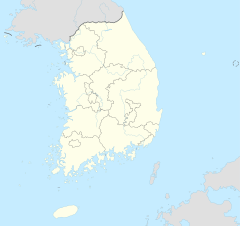Korea Astronomy and Space Science Institute
Location of the observatories in South Korea |
The Korea Astronomy and Space Science Institute (KASI) is the state research institute for astronomy of the Republic of Korea founded in 1974 . It is located between the cities of Daejeon and Sejong . The KASI leads several observatories in Korea and is involved in international observatories.
Headquarters building
Observatories
Taeduk Radio Astronomy Observatory
The Taeduk Radio Astronomy Observatory (TRAO) is a radio observatory that has a radio telescope with an aperture of 14 meters.
Sobaeksan Optical Astronomy Observatory
The Sobaeksan Optical Astronomy Observatory (SOAO) is an observatory in Tanyang in the Sobaek Mountains. It was opened in 1978 and is equipped with a 61 cm reflector telescope .
Bohyunsan Optical Astronomy Observatory
The Bohyunsan Optical Astronomy Observatory (BOAO) is an observatory on Mount Bohyun in Youngchun. It was founded in 1996 and has a Ritchey-Chrétien telescope with a diameter of 1.8 meters.
Korean VLBI Network
The Korean VLBI Network (KVN) is a radio observatory built in the period 2001-2008 consisting of three interferometrically coupled telescopes 300-500 km apart in Seoul , Ulsan , and Seogwipo on Jeju Island . The identical radio telescopes have a diameter of 21 meters and were initially able to carry out observations in the 2-, 8-, 22- and 43-GHz bands, and later also in the 86- and 129-GHz bands. A coupling with the Japanese VERA array to increase the base length to over 2,000 kilometers with a corresponding improvement in angular resolution was used in 2014, for example, to investigate methanol masers .
KMTNet
The KMTNet is a network of three reflector telescopes at the Cerro Tololo Inter-American Observatory , Siding Spring Observatory and South African Astronomical Observatory locations to enable uninterrupted observation of a region of the sky. The telescopes have an aperture of 1.6 m and are connected to a 340 megapixel - CCD camera equipped for observing a region of the sky from 2 ° x2 °.
Web links
- Homepage (s)





